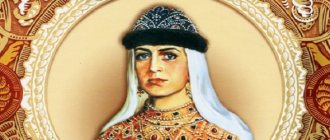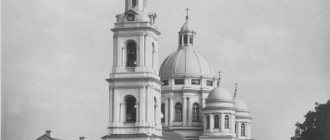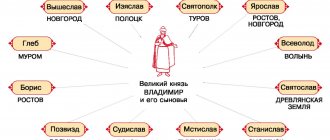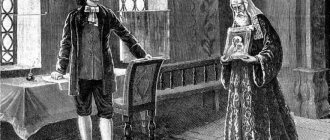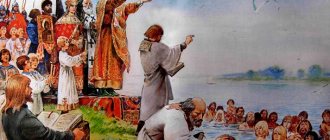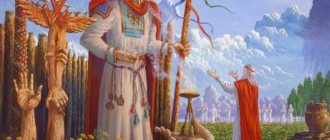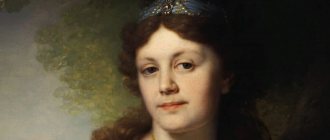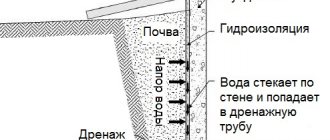Speaking briefly about the progress of Peter I's church reform, it is important to note its thoughtful and purposeful nature. At the end of the reform, Russia, as a result, developed an absolute monarchy, and the church finally lost its influence on the government.
The material was prepared jointly with a teacher of the highest category
Alexandrova Ekaterina Valerievna.
Experience as a history and social studies teacher - 11 years.
Church reform of Peter I
From 1701 to 1722, Peter the Great tried to reduce the authority of the Church and establish control over its administrative and financial activities. The prerequisites for this were the protest of the Church against the changes taking place in the country, calling the king the Antichrist. Having enormous authority, comparable to the authority and complete power of Peter himself, the Patriarch of Moscow and All Rus' was the main political competitor of the Russian reformer tsar.
Rice. 1. Young Peter.
Among other things, the Church had accumulated enormous wealth, which Peter needed to wage war with the Swedes. All this tied Peter’s hands to use all the country’s resources for the sake of the desired victory.
The tsar was faced with the task of eliminating the economic and administrative autonomy of the Church and reducing the number of clergy.
Causes
First reason. The attitude of the Russian Orthodox Church towards Peter the Great and his activities was quite clear - hostility. This hostility was especially open among the last patriarch of the Russian Orthodox Church, Adrian (he was patriarch from 1690 to 1700).
The Orthodox elders perceived Peter as nothing other than the Antichrist, who did not value Orthodox traditions and customs. How this was expressed, I think you know: the tsar did not value his legal wife Avdotya Lopukhina at all and toured with might and main on the side. And let’s not forget about the bells on the cannons after the Narva defeat during the Northern War of 1700
The second reason was that it was necessary to put a big and bold end to the confrontation between secular and church authorities. Under Alexei Mikhailovich, it ended with the deposition of Patriarch Nikon in 1666. And only: the new patriarchs were not so hot towards the kings.
The economic basis of the independence of the church was its own estates, in which peasants lived and paid duties, you yourself can guess in whose favor. Something had to be done about this too.
Thus, it was necessary to turn the church into an obedient instrument of government.
Table “The essence of the reforms being carried out”
| Events | Year | Goals | Content |
| Appointment of the “Guardian and Manager of the Patriarchal Throne” | 1700 | Replace the election of the Patriarch by the Church with an imperial appointment | Peter personally appointed a new Patriarch |
| Secularization of peasants and lands | 1701 | Elimination of the financial autonomy of the Church | Church peasants and lands were transferred to the management of the State. |
| Monastic prohibitions | 1701 | Reduce the number of clergy | It is forbidden to build new monasteries and conduct a census of monks |
| Senate control over the Church | 1711 | Restriction of administrative freedom of the Church | Creation of the Senate and transfer of church affairs to its management |
| Decree limiting the number of clergy | 1716 | Improving the efficiency of human resource allocation | Servants are assigned to a specific parish and are prohibited from traveling |
| Preparatory stage for the abolition of the Patriarchate | 1717-1720 | Get full power in the empire | Development of a project for the establishment of the Theological College |
January 25, 1721 is the date of the final victory of the emperor over the patriarch, when the patriarchate was abolished.
TOP 4 articles that are read along with this
- 1. Peter's reforms
- 2. Reforms of Peter 1 (table)
- 3. The era of palace coups in Russia
- 4. The result of the military reforms of Peter 1 was...
Rice. 2. Prosecutor General Yaguzhinsky.
The relevance of the topic was not only under Peter, but also under the Bolsheviks, when not only church power was abolished, but also the very structure and organization of the Church.
Rice. 3. Building of 12 colleges.
The Spiritual College also had another name - the Governing Synod. A secular official, not a clergyman, was appointed to the position of Chief Prosecutor of the Synod.
As a result, the reform of the Church of Peter the Great had its pros and cons. Thus, Peter discovered for himself the opportunity to lead the country towards Europeanization, however, if this power began to be abused, in the hands of another person Russia could find itself in a despotic regime. However, the consequences are a reduction in the role of the church in society, a reduction in its financial independence and the number of servants of the Lord.
Gradually, all institutions began to concentrate around St. Petersburg, including church ones. The activities of the Synod were monitored by fiscal services.
Peter also introduced church schools. According to his plan, every bishop was obliged to have a school for children at home or at home and provide primary education.
Contents of the reform
In 1700, Patriarch Adrian died, after which Peter did not appoint a successor to him.
In 1701, the Monastery Prikaz was restored, under whose jurisdiction the Patriarchal Courtyard, bishop's houses and farms were transferred. Boyar I.A. was appointed head of the order. Musin-Pushkin.
Later, a number of decrees were issued that significantly reduced the independence of the church. Particular attention was focused on the monasteries:
- the monks were assigned to their monasteries;
- Those who were not tonsured were evicted from the monasteries;
- women were allowed to enter a monastery only after 40 years of age;
- the economy of the monasteries was transferred to the subordination of the Monastic Order;
- Only the sick and infirm were to be left in the almshouses;
Note 1
Monasteries were allocated salaries (cash and grain) from the state treasury, but the church was prohibited from owning estates and lands.
The schismatics were no longer persecuted, but it was established that they would pay double tax. Other representatives of other religions were allowed to practice their religion freely.
To raise the level of morality, everyone was obliged to confess annually, and for evasion they had to pay a fine. In 1718, it was ordered to stand “with reverence and silence” during church services, and again a fine was levied for violation. In general, Peter I loved to celebrate his military victories with church services. For example, messages about victory in the Battle of Poltava were accompanied by a prayer service and five days of church bells.
Peter also actively fought against beggary. Everyone who asked for alms was sent to the Monastic Prikaz, and those who gave it were asked to send the money to almshouses.
Test on the topic
- Question 1 of 10
What was not included in the list of tasks facing Peter I in relation to the Church?
Start test (new tab)
Hall of Fame
To get here, take the test.
-
- Lyubov Kokovikhina
10/10
- Aleksey Ivanov
10/10
- Dina Treiman
8/10
- Tatiana Tkacheva
9/10
- Oksana Zagorodnikova
7/10
Results and significance
Peter the Great was a revolutionary by nature and started a real revolution in all spheres of social life in the country. As a result of church reform:
- The church became a servant of the state, a public service, which, along with the functions of worship, also performed serious administrative (maintenance of scribe books, “registration” of marriages, etc.) and ideological functions. This can be regarded as a plus for public administration.
- It created a serious split in Russian society between the top and bottom. This can be regarded as a minus, since a misunderstanding began to develop between the “tops” and the “bottoms” of Russian society.
In general, this reform activity reminds me personally of the process of the Reformation in Western Europe. But it came from below: the people demanded a “cheap” and democratic church. In Russia, the state simply robbed the church of its wealth and began to mercilessly exploit it in its own interests.
On my own behalf, I can say that if you are taking the Unified State Examination in history this year, and all of the above is new to you, then I strongly recommend taking our preparation courses so as not to make mistakes in the real exam.
Sincerely, Andrey Puchkov
Share on social media networks
What was the central government reform?
The reform of central government was one of Peter's first reforms. It should be noted that this reformation lasted a long time, since it was based on the need to completely restructure the work of Russian authorities.
Peter I's reforms in the field of central government began back in 1699. At the initial stage, this change affected only the Boyar Duma, which was renamed the Near Chancellery. With this step, the Russian Tsar alienated the boyars from power and allowed power to be concentrated in a chancellery that was more pliable and loyal to him. This was an important step that required priority implementation, since it allowed the centralization of government of the country.
Senate and its functions
At the next stage, the king organized the Senate as the main government body in the country. This happened in 1711. The Senate has become one of the key bodies in governing the country, with the broadest powers, which include the following:
- Legislative activity
- Administrative activities
- Judicial functions in the country
- Control functions over other bodies
The Senate consisted of 9 people. These were representatives of noble families, or people whom Peter himself elevated. In this form, the Senate existed until 1722, when the emperor approved the position of prosecutor general, who controlled the legality of the activities of the Senate. Before this, this body was independent and did not bear any responsibility.
Creation of boards
The reform of central government continued in 1718. It took the reformer tsar three whole years (1718-1720) to get rid of the last legacy of his predecessors - orders. All orders in the country were abolished and collegiums took their place. There was no actual difference between the boards and orders, but in order to radically change the administrative apparatus, Peter went through this transformation. In total, the following bodies were created:
- Collegium of Foreign Affairs. She was in charge of the state's foreign policy.
- Military Collegium. She was engaged in ground forces.
- Admiralty College. Controlled the Russian navy.
- Office of Justice. She handled litigation matters, including civil and criminal cases.
- Berg College. It controlled the country's mining industry, as well as factories for this industry.
- Manufactory Collegium. She was involved in the entire manufacturing industry of Russia.
In fact, only one difference between boards and orders can be identified. If in the latter the decision was always made by one person, then after the reform all decisions were made collectively. Of course, not many people decided, but the leader always had several advisers. They helped me make the right decision. After the introduction of the new system, a special system was developed to control the activities of the boards. For these purposes, the General Regulations were created. It was not general, but was published for each board in accordance with its specific work.
Secret Chancery
Peter created a secret office in the country that dealt with state crimes. This office replaced the Preobrazhensky order, which dealt with the same issues. It was a specific government body that was not subordinate to anyone except Peter the Great. In fact, with the help of the secret chancellery, the emperor maintained order in the country.
The significance of Peter's reforms
The reforms of Peter 1 actually completely changed the order of life in Russia. Some of the reforms actually brought a positive effect, while others created negative preconditions. For example, the reform of local government led to a sharp increase in the number of officials, as a result of which corruption and embezzlement in the country literally went off scale.
In general, the reforms of Peter 1 had the following meaning:
- The power of the state was strengthened.
- The upper classes of society were actually equal in opportunities and rights. Thus, the boundaries between classes were erased.
- Complete subordination of the church to state power.
The results of the reforms cannot be clearly identified, since they had many negative aspects, but you can learn about this from our special material.
Objectives and prerequisites
The main reason for the transformation of the church hierarchy was the excessive power of the patriarchate. Peter 1 sought to create a strong state with an absolutist model of governance, which eliminates the possibility of challenging the decrees and will of the tsar. Dissatisfaction with the clergy was intensified by aggressive propaganda among the common population of the idea of the devilish origin of the ruler, undermining his authority. Leaflets with slogans, essays, and petitions about “the king is not from God” were distributed in villages and cities.
In the scheme of depriving religious powers of the opportunity to directly intervene in politics, the tsar also paid attention to the issue of obtaining an additional source of financing for the state treasury. Traditionally, resources received by churches as donations from the population remained unaccountable to the country's budget. This result could be achieved in several ways:
- strictly regulate the staff of the church;
- conducting an audit with the subsequent appointment of a responsible person to control financial flows;
- creating a list of rights and responsibilities of the church;
- restrictions on the construction of monasteries.
The wars unleashed and the reforms carried out in the country required not only financial influence, but also human resources, so transformations in the spiritual sphere also affected the issue of mass beggary. The king sought to prohibit the working population from living on alms, believing that only the crippled or the blessed could ask for alms.
